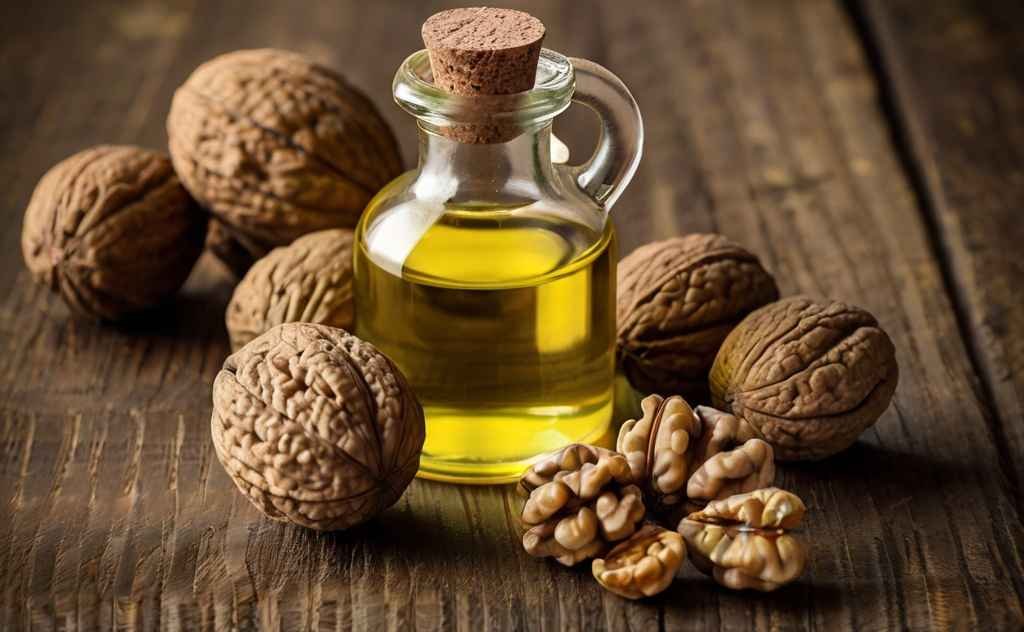Walnut oil is a premium product derived from the nuts of the walnut tree (Juglans regia). Known for its rich, nutty flavor and numerous health benefits, walnut oil is used in culinary applications as well as in cosmetics and skincare products. The walnut oil is made is several stages, from harvesting and drying the walnuts to extracting and refining the oil.
Harvesting Walnuts
The process begins with the harvesting of walnuts. Walnuts are typically harvested in the late summer to early fall, depending on the region and variety. The nuts are collected once they have fallen to the ground or shaken off the tree. Harvesting can be done manually or using mechanical shakers and sweepers.
Drying and Storing
After harvesting, walnuts must be dried to reduce moisture content, which prevents mold growth and ensures long-term storage. The nuts are spread out in thin layers and air-dried in a well-ventilated area or dried using commercial dehydrators. The drying process can take several days to a couple of weeks, depending on the weather and drying method.
Once dried, walnut oil is made by storing in a cool, dry place until they are ready for processing. Proper storage is crucial to maintaining the quality of the nuts and preventing rancidity.
Shelling and Sorting
Before oil extraction, the walnuts need to be shelled. Walnut oil is made by cracking the hard outer shell to release the nut kernels. Shelling can be done manually or using mechanical shellers. The kernels are then sorted to remove any remaining shell fragments and to select the highest quality nuts for oil production.
Explore: How much walnut oil to take per day?

Pressing
Walnut oil is made by two primary methods of extracting walnut oil: cold pressing and expeller pressing.
- Cold Pressing: Cold pressing is the traditional method of extracting walnut oil and is preferred for producing high-quality oil with maximum nutritional benefits. In this method, the walnut kernels are ground into a paste and then pressed at a low temperature (below 49°C or 120°F) to extract the oil. This process preserves the oil’s natural flavor, aroma, and nutritional content.
- Expeller Pressing: Expeller pressing involves grinding the walnut kernels and then pressing them at a slightly higher temperature. This method yields more oil but may result in a slight loss of nutritional value and flavor compared to cold-pressed oil. However, expeller pressing is more efficient and cost-effective for large-scale production.
Explore: Benefits of Walnut oil for skin whitening
Filtration and Refining
After pressing, the crude walnut oil undergoes filtration to remove any solid particles and impurities. The walnut oil is made by typically filtered through fine mesh filters or centrifuged to achieve a clear product.
For some applications, the oil may undergo further refining processes, such as deodorization and bleaching, to remove any unwanted odors, colors, or residues. However, many producers of high-quality walnut oil prefer to keep the oil unrefined to maintain its natural characteristics.
Bottling and Packaging after walnut oil is made
Once filtered and refined (if necessary), the walnut oil is ready for bottling. The oil is carefully poured into clean, sterilized bottles or containers, which are then sealed to preserve freshness. Dark glass bottles are often used to protect the oil from light, which can degrade its quality over time.
Quality Control
Throughout the production process, quality control measures are implemented to ensure that the walnut oil meets high standards. This includes regular testing for purity, flavor, and nutritional content. Proper labeling is also essential to inform consumers about the product’s origins, extraction method, and best-before date.
Explore: How to use walnut oil ?

Conclusion
Walnut oil production is a meticulous process that combines traditional methods with modern technology to produce a high-quality, nutritious product. From harvesting the walnuts to pressing and bottling the oil, each step is crucial in ensuring that the final product retains its rich flavor and health benefits. Whether used in cooking or skincare, walnut oil continues to be valued for its unique qualities and versatile applications.
FAQs
- What are the differences between cold-pressed and expeller-pressed walnut oil?
Cold-pressed walnut oil is extracted at a low temperature to preserve its nutritional value and flavor, while expeller-pressed oil is extracted at a slightly higher temperature, yielding more oil but potentially losing some nutritional benefits and flavor. - What are the health benefits of walnut oil?
Walnut oil is rich in omega-3 fatty acids, antioxidants, and vitamins such as vitamin E. It supports heart health, improves skin and hair condition, and has anti-inflammatory properties. - How should walnut oil be stored?
Walnut oil should be stored in a cool, dark place, preferably in a dark glass bottle to protect it from light. Once opened, it is best to refrigerate the oil to extend its shelf life and prevent rancidity. - Can I cook with walnut oil?
Yes, walnut oil can be used for cooking, but it has a low smoke point, making it more suitable for salad dressings, drizzling over dishes, or low-heat cooking rather than high-heat frying. - Is walnut oil safe for people with nut allergies?
People with nut allergies should avoid walnut oil as it is derived from nuts and can trigger allergic reactions. Always consult with a healthcare provider if you have concerns about food allergies. - Can walnut oil be used in skincare?
Yes, walnut oil is commonly used in skincare products due to its moisturizing and anti-inflammatory properties. It can help nourish the skin, reduce signs of aging, and treat dry or irritated skin. - What are the culinary uses of walnut oil?
Walnut oil is versatile in the kitchen. It can be used in salad dressings, marinades, sauces, and as a finishing oil for drizzling over dishes like pasta, grilled vegetables, and desserts. - Is there a difference between refined and unrefined walnut oil?
Yes, unrefined walnut oil retains more of its natural flavor, aroma, and nutrients, while refined walnut oil has been processed to remove impurities, which can result in a milder taste and longer shelf life. - Can walnut oil go bad?
Yes, walnut oil can go rancid due to its high unsaturated fat content. Proper storage in a cool, dark place and refrigeration after opening can help prolong its shelf life. - How can I tell if walnut oil has gone bad?
Rancid walnut oil will have an off smell, bitter taste, and possibly a change in color. If the oil smells or tastes unpleasant, it should be discarded. - Is walnut oil environmentally friendly?
Walnut oil production can be environmentally friendly if sourced from sustainable farms that use eco-friendly practices. It’s important to look for certifications or information about the producer’s sustainability efforts. - Can walnut oil be used in baking?
Yes, walnut oil can be used in baking to add a subtle nutty flavor to cakes, cookies, and bread. However, its strong flavor can be overpowering in some recipes, so it’s best used in moderation.


3 Comments
[…] Explore: How walnut oil is made? […]
[…] Explore: How walnut oil is made? […]
[…] Explore: How walnut oil is made? […]